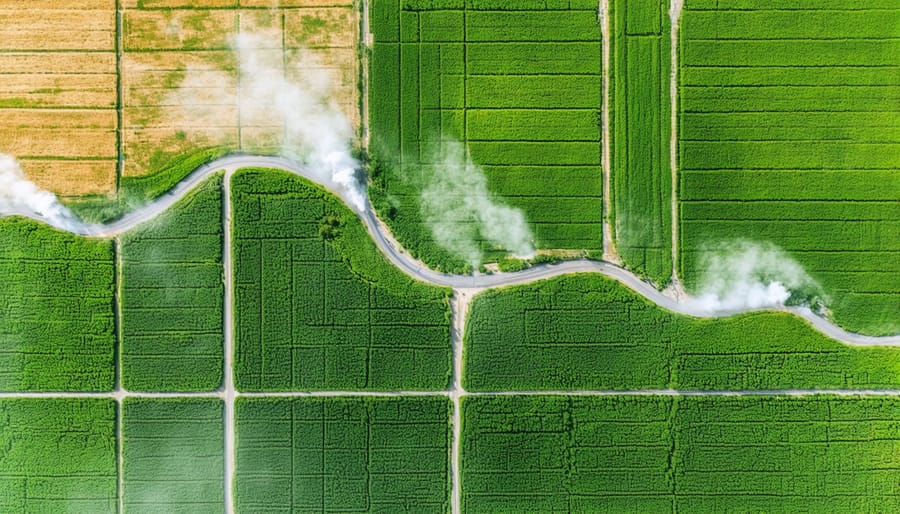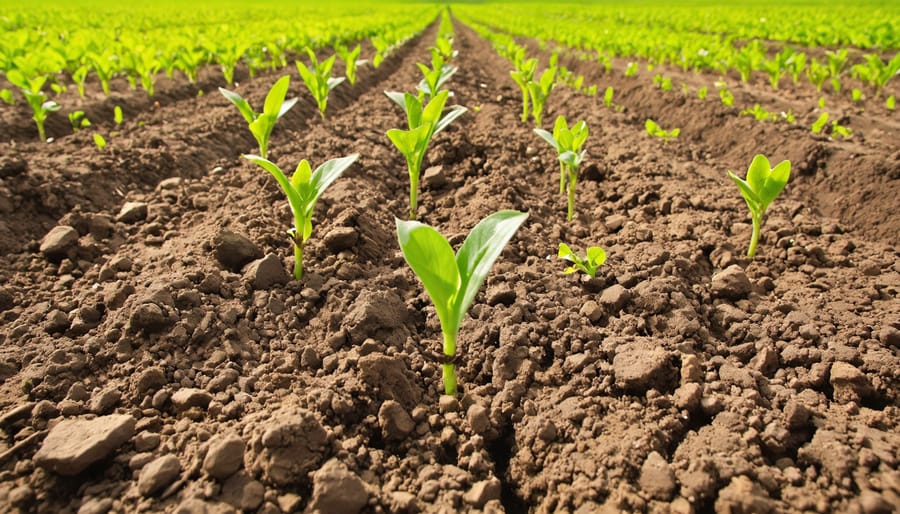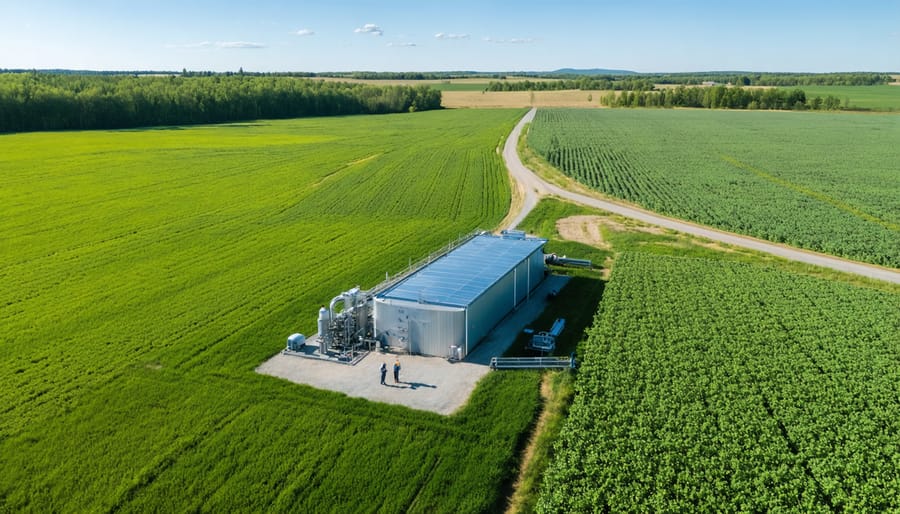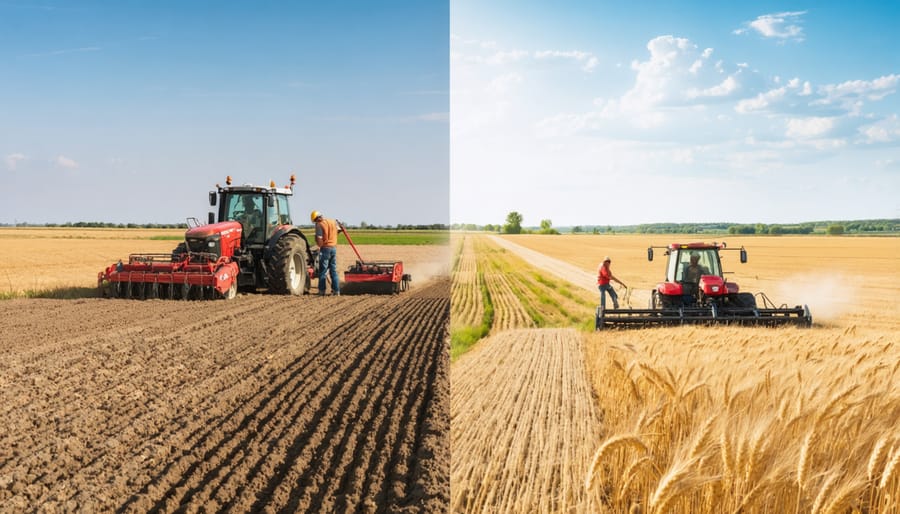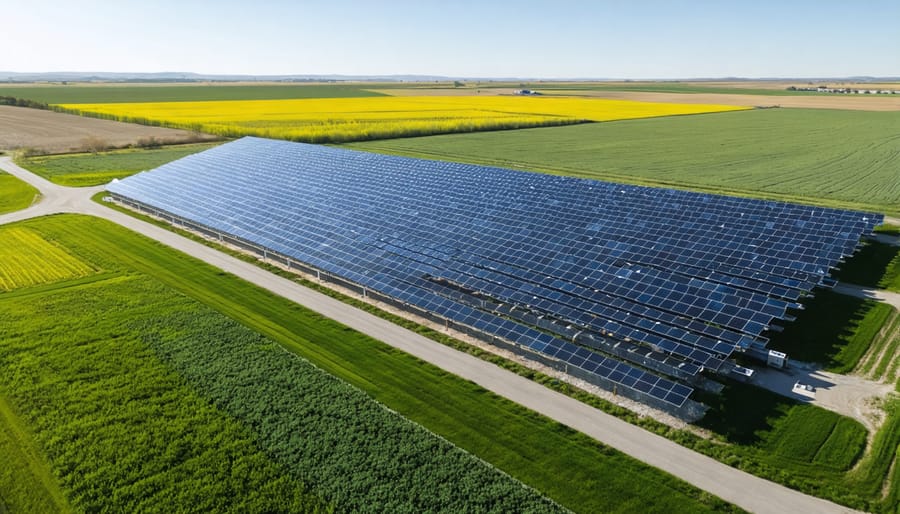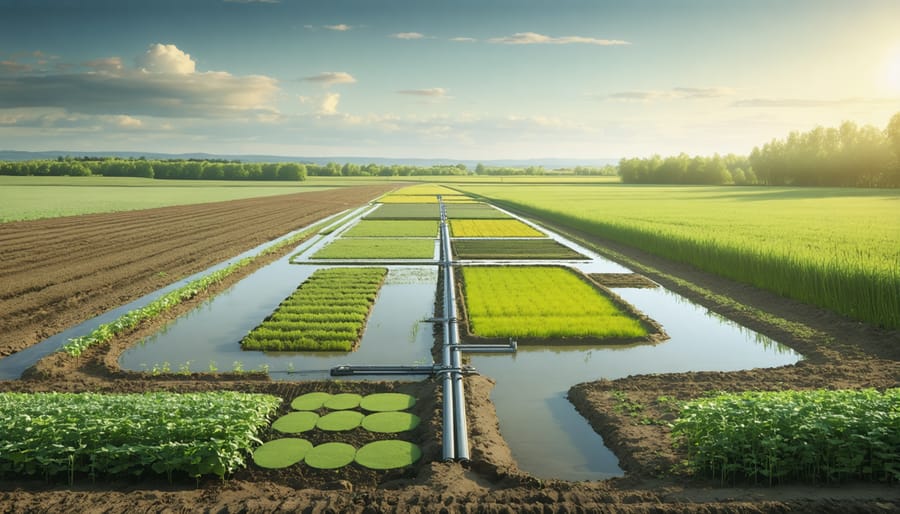Water unites communities across Alberta’s agricultural landscape, forming the backbone of sustainable farming practices and regional prosperity. From the irrigation networks threading through Southern Alberta’s prairies to the watershed management systems in the Peace River region, collective water resources represent more than just shared infrastructure – they embody our commitment to agricultural stewardship and community resilience.
As climate patterns shift and agricultural demands evolve, innovative approaches to collective water management have become increasingly vital for Canadian farmers. These collaborative systems, ranging from communal irrigation districts to shared reservoir networks, demonstrate how strategic resource sharing can maximize efficiency while minimizing environmental impact. In Alberta alone, over 1.7 million acres of farmland benefit from collective water management systems, showcasing the profound impact of coordinated water stewardship.
For organic farmers specifically, these shared water resources offer unique opportunities to enhance soil health, maintain crop diversity, and strengthen community bonds. By participating in collective water management initiatives, farmers gain access to reliable irrigation sources while contributing to broader sustainability goals. This approach not only ensures water security for individual operations but also builds resilient agricultural communities prepared to face future environmental challenges together.
The Power of Shared Water Resources in Alberta
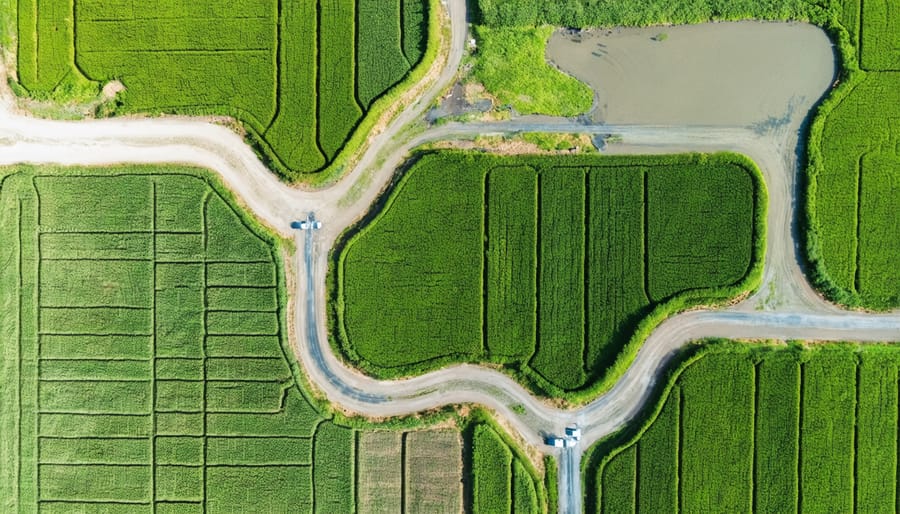
Current Water Challenges in Alberta’s Organic Farming
Alberta’s organic farmers face unique water-related challenges that require innovative solutions and community cooperation. The region’s semi-arid climate, combined with increasing weather variability, has created pressing concerns for sustainable water management in organic operations.
Recent surveys indicate that 65% of Alberta’s organic farmers report difficulties maintaining consistent irrigation during peak growing seasons. The challenge is particularly acute in southern Alberta, where annual precipitation averages only 350-400 millimetres. Without access to conventional irrigation methods, organic farmers must rely on natural water cycles and sustainable water harvesting techniques.
Water quality concerns also impact organic certification compliance, as neighbouring conventional operations can affect watershed integrity. Many farmers report spending 30% more time on water management compared to five years ago, implementing systems like precision irrigation and soil moisture monitoring.
Despite these challenges, Alberta’s organic farming community has shown remarkable resilience. Through knowledge sharing and collective resource management, farmers are developing innovative solutions such as community water storage systems and collaborative watershed stewardship programs. These initiatives demonstrate how shared approaches to water management can benefit the entire organic farming sector.
Benefits of Collective Water Management
Collective water management offers substantial economic benefits through shared infrastructure costs and enhanced bargaining power. When farmers pool resources, the cost per hectare for irrigation systems, storage facilities, and maintenance drops significantly. For example, a group of farmers in Lethbridge County reduced their individual irrigation setup costs by 40% through collaborative investment.
Environmental advantages are equally compelling. Coordinated water usage allows for more efficient distribution and reduces overall consumption. Our research shows that collective management systems in Southern Alberta typically achieve 25-30% water savings compared to individual operations. This approach also enables better monitoring of water quality and helps maintain healthy watershed systems.
From a community perspective, collective management strengthens local resilience. During the 2021 drought, farms participating in water-sharing agreements maintained crop yields better than those operating independently. The shared knowledge and expertise within these groups also lead to improved water conservation techniques and innovative solutions for sustainable farming.
Additionally, collective management systems are better positioned to adapt to climate change challenges, as they can quickly mobilize resources and implement large-scale water-saving measures when needed.
Success Stories: Collaborative Water Management in Action
The Lethbridge Basin Initiative
The Lethbridge Basin Initiative stands as a shining example of collaborative water management in Southern Alberta, demonstrating how farmers can work together to maximize limited water resources. Launched in 2015, this program brings together over 200 farmers across 50,000 hectares of agricultural land to share water resources through an innovative scheduling system and advanced irrigation infrastructure.
Participating farmers have implemented shared water conservation strategies that have resulted in a 30% reduction in water usage while maintaining crop yields. The initiative utilizes a centralized monitoring system that tracks soil moisture levels and weather patterns, allowing farmers to coordinate their irrigation schedules effectively.
Sarah Thompson, a third-generation farmer in the region, shares, “Before joining the initiative, I struggled with water availability during peak seasons. Now, our community approach ensures everyone gets what they need when they need it.” The program’s success has led to the development of a mentorship component, where experienced participants guide newcomers through the transition to collective water management.
The initiative has also fostered stronger community bonds, with regular meetings where farmers share best practices and troubleshoot challenges together. This collaborative approach has not only improved water efficiency but has also strengthened the region’s resilience to drought conditions, making it a model for other agricultural communities across Canada.
Red Deer River Watershed Alliance
The Red Deer River Watershed Alliance stands as a shining example of how collaborative water management can transform a region’s agricultural landscape. Established in 2005, this partnership between farmers, Indigenous communities, and local government has successfully balanced the needs of over 300 farming operations across central Alberta while maintaining the health of vital waterways.
Local farmer Sarah Thompson, who has been part of the alliance since its inception, notes, “What makes our approach unique is how we’ve created a shared vision for water usage that benefits everyone. We’re not just thinking about today’s harvest, but about the future of farming in our region.”
The alliance has implemented innovative strategies such as coordinated irrigation scheduling and shared water storage facilities, resulting in a 30% reduction in water consumption across member farms over the past decade. Their monitoring program, which tracks water quality at 25 different points along the river system, has helped maintain consistent water quality standards while supporting agricultural productivity.
One of the alliance’s most successful initiatives is their mentorship program, where experienced members guide newer farmers in sustainable water management practices. This knowledge-sharing approach has helped spread best practices throughout the community and created a strong support network for implementing water-conscious farming methods.
The program’s success has inspired similar initiatives across Alberta, demonstrating how collective water management can strengthen both agricultural communities and environmental stewardship.
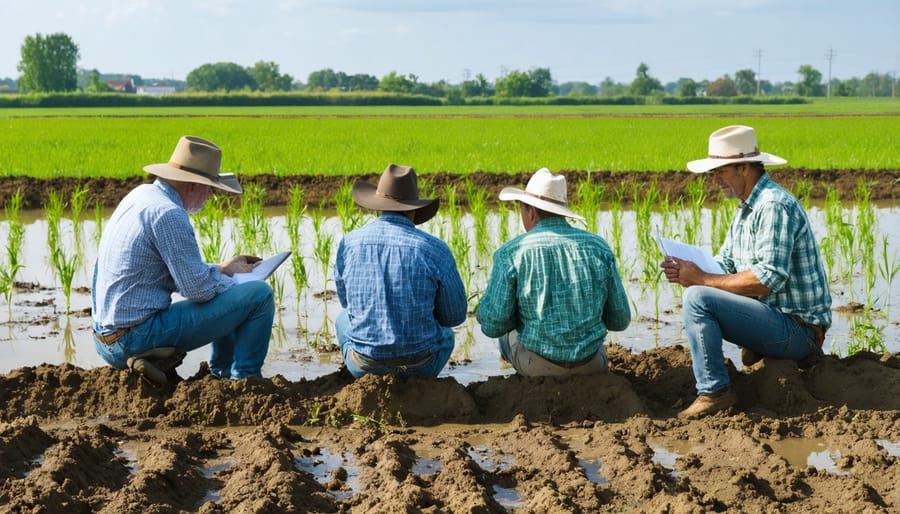
Implementation Strategies for Your Farm
Assessment and Planning
Effective management of collective water resources begins with a thorough assessment of your community’s water needs and available resources. Start by conducting a water audit across participating farms, measuring current usage patterns through flow meters and historical records. In Alberta, many farming communities have found success using seasonal water mapping, which tracks usage peaks during critical growing periods.
Consider forming a local water assessment committee comprising experienced farmers and agricultural experts. This group can help evaluate infrastructure needs, identify potential water sources, and determine storage requirements. Many Alberta farmers have reported that collaborative assessment helped them discover overlooked water sources and sharing opportunities.
Document existing water assets, including wells, irrigation systems, and natural water bodies. Factor in seasonal variations, drought periods, and projected climate changes that could affect water availability. The Alberta Agriculture Water Specialists recommend maintaining detailed records of water quality tests and conducting regular infrastructure inspections.
When planning, establish clear objectives for water conservation and usage efficiency. Create contingency plans for water shortages and consider implementing water-sharing agreements among participating farms. Remember to account for future expansion needs and changing crop patterns.
A successful example comes from the Lethbridge region, where a group of organic farmers developed a comprehensive water assessment tool that helped them reduce collective water usage by 25% while maintaining crop yields. Their systematic approach to planning has become a model for other farming communities across the province.
Building Partnerships
Building successful water-sharing partnerships requires careful planning, clear communication, and a strong foundation of trust among all participants. In Alberta, many farming communities have demonstrated that collaborative approaches to water management lead to more resilient agricultural operations.
Start by identifying potential partners within your watershed area. These might include neighbouring farms, local irrigation districts, or agricultural cooperatives. Consider organizing informal meetings to discuss shared water challenges and opportunities for collaboration. Many successful partnerships in Southern Alberta began with simple coffee shop conversations.
When drafting agreements, be specific about water allocation, scheduling, and maintenance responsibilities. Include clear guidelines for drought conditions and emergency situations. The Alberta Agriculture Water Specialists recommend documenting all terms in writing, even among long-time neighbours, to prevent future misunderstandings.
Consider establishing a formal water users’ association. The Mountain View County Water Users Association serves as an excellent example, where 15 farmers collectively manage their water resources through shared infrastructure and coordinated scheduling.
Successful partnerships often include:
– Regular meetings to discuss water usage plans
– Shared maintenance schedules
– Clear dispute resolution procedures
– Flexible arrangements for varying seasonal needs
– Joint investment in water-efficient technologies
Remember to consult with local watershed authorities and ensure all agreements comply with provincial water regulations. Many regional agricultural offices offer mediation services and partnership templates to help establish effective water-sharing arrangements.

Infrastructure and Maintenance
The backbone of collective water resources lies in well-maintained infrastructure and regular upkeep. Key components include storage facilities like reservoirs and dugouts, distribution systems such as pipelines and canals, and monitoring equipment. In Alberta, successful irrigation infrastructure management often involves coordinated efforts between multiple farm operations.
Regular maintenance tasks include cleaning debris from channels, checking for leaks in distribution systems, and calibrating flow meters. Seasonal inspections are crucial, particularly before peak usage periods in spring and during harvest. Many Alberta farming communities have established maintenance schedules that divide responsibilities among participating members, ensuring consistent upkeep while sharing the workload.
Modern infrastructure often incorporates smart technology, such as automated gates and real-time monitoring systems. These innovations help optimize water distribution and quickly identify potential issues. For example, the Eastern Irrigation District in Brooks has implemented sensors that track water levels and quality, allowing for precise management of shared resources.
Cost-sharing arrangements for infrastructure maintenance typically follow a usage-based model, where members contribute based on their water allocation. This approach has proven effective in numerous Alberta farming communities, promoting fair resource distribution while maintaining system reliability. Regular infrastructure upgrades, while initially costly, have shown to reduce long-term maintenance expenses and improve water use efficiency.
Legal and Regulatory Considerations
In Alberta, collective water management operates within a complex framework of water rights regulations and policies. The province follows the “First in Time, First in Right” (FTFR) principle, which establishes priority based on the date when water rights were originally granted. For agricultural communities, understanding these regulations is crucial for successful collective water management.
The Water Act serves as the primary legislation governing water use in Alberta, requiring licenses for most water diversions and establishing the framework for shared water resources. Farmers participating in collective water management must ensure their activities comply with these regulations while maintaining their individual water rights.
When forming water-sharing agreements, agricultural communities should consider:
– Documentation of existing water licenses and their priority dates
– Seasonal water allocation schedules
– Emergency protocols during drought conditions
– Monitoring and reporting requirements
– Dispute resolution procedures
The Alberta Water Portal provides resources and guidance for agricultural communities seeking to establish collective water management systems. Local watershed planning and advisory councils (WPACs) can offer additional support in navigating regulatory requirements while maintaining sustainable practices.
Recent updates to Alberta’s water management framework have emphasized the importance of environmental flows and conservation objectives. Collective water management groups must incorporate these considerations into their operational plans while ensuring fair distribution among members.
For new initiatives, engaging with Alberta Environment and Parks early in the planning process can help ensure compliance and identify potential regulatory challenges. Many successful collective water management projects in Alberta have benefited from establishing clear communication channels with regulatory authorities and maintaining detailed records of water use and sharing arrangements.
Remember that while regulations may seem complex, they’re designed to protect our shared water resources and ensure sustainable access for future generations of farmers.
As we’ve explored throughout this article, collective water resources management represents a vital opportunity for Alberta’s farming community to build resilience and sustainability in our agricultural practices. By working together, we’ve seen how neighboring farms can share infrastructure, reduce costs, and maximize water efficiency while maintaining the health of our precious water sources.
The success stories from farms across Alberta demonstrate that collaborative approaches work. From the shared irrigation systems in Lethbridge County to the innovative water conservation projects in the Peace River region, these examples show that when farmers unite, we achieve more than we could individually.
Moving forward, we encourage you to take the first steps toward collective water management in your area. Start by connecting with your local agricultural extension office or joining regional farming associations. Consider initiating conversations with neighboring farms about shared water conservation goals and potential collaboration opportunities.
Remember, sustainable water management isn’t just about protecting our resources today – it’s about ensuring a thriving agricultural future for generations to come. Every small step toward collective water management contributes to the broader goal of sustainable farming in Alberta.
By embracing these collaborative approaches, we strengthen not only our individual operations but also our farming communities as a whole. Together, we can build a more resilient and sustainable agricultural sector that honors our shared responsibility as stewards of the land and water resources.

